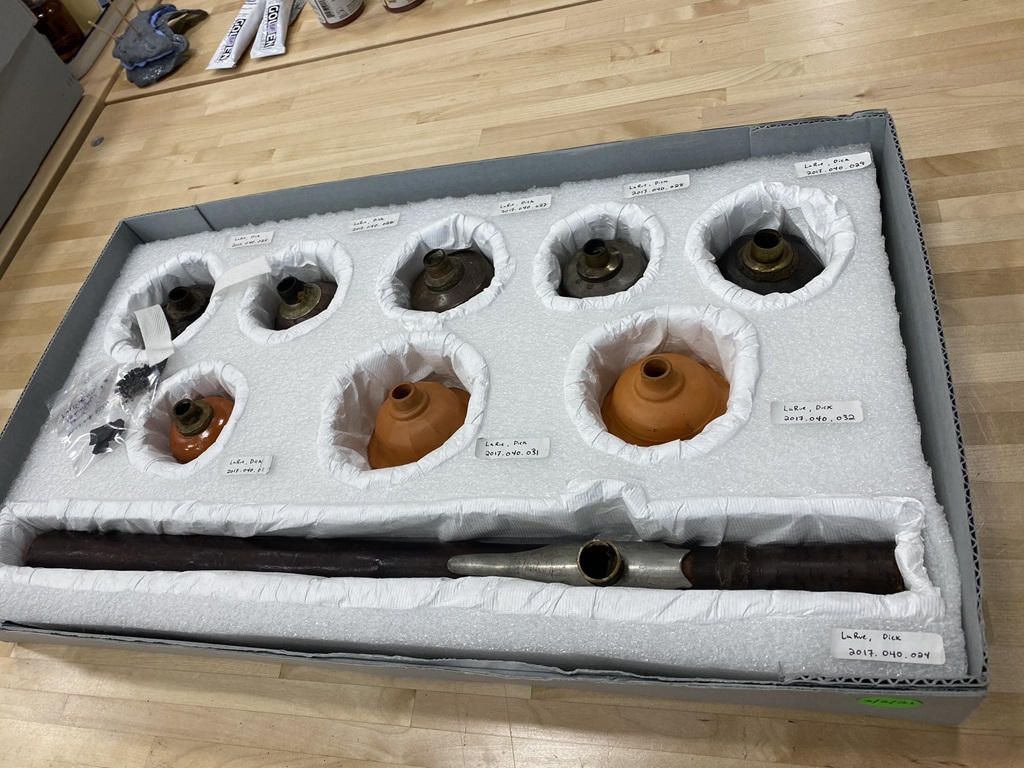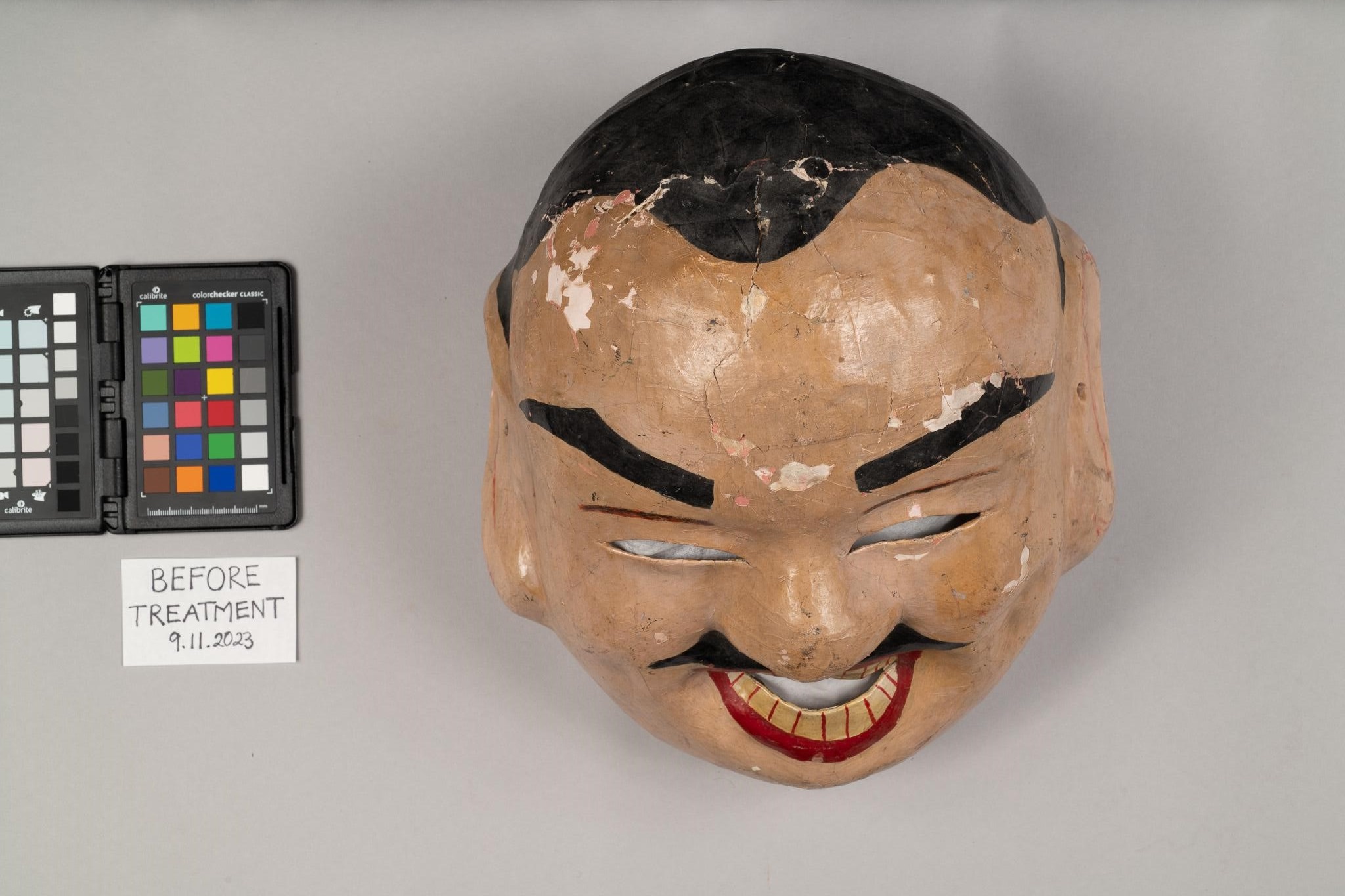Over the course of the Fall 2023 semester NYU Conservation Center graduate students collaborated with MOCA collections staff to treat vulnerable objects in the museum’s collection. These objects showed damage associated with the fire in the museum’s collections storage in January of 2020, either from the fire itself or from exposure to water during firefighting efforts. Today we will look at two objects from this collaboration: a nineteenth-century opium pipe made from bamboo, and a big-headed monk mask (daaih tauh taht) made from papier-mâché.
Conservation Treatment of a Nineteenth-century Opium Pipe and a Big-headed Monk Mask (Daaih Tauh Taht) from the MOCA Collections by Halina Piasecki

Above you can see an image of the opium pipe, which can be found in the collection with its accession number, 2017.040.024. This pipe was donated to MOCA by Dick LaRue in 2017. He purchased it in the late 1960’s from the widow of his father’s friend, since she was selling her late husband’s estate. This man, the original purchaser of the pipe, was stationed in China in the early 1900’s, and worked for the American governmental agency that was a forerunner to the DEA (Drug Enforcement Agency).
Opium pipes were used in China and elsewhere starting as early as the Tang period (from 618-907 CE) but Opium smoking really took off in China after the European introduction of tobacco in the late 16th Century. Opium was not often smoked in isolation, and tobacco is historically known as the most common additive to the opium smoking system. Pipes are traditionally made from bamboo, and have a metal saddle with an attachment that connects to the metal collar of each ceramic bowl. The bowls seen in this assemblage (which you can see in the image below) appear to be in the mid nineteenth century style, with an upside-down bell shape with a sealed mouth and a convex surface with the needle hole in the center. The convex surface of the bowl is a mid nineteenth century intervention intended to facilitate kneading of the opium while cooking it in preparation for the pipe. The softened drug would then be fed into the bowl through the use of an opium needle, since the best effects of opium were obtained from heating the substance as opposed to fully combusting or burning it.
Much of the condition of this object is probably evidence of use. The literature tells us that the darkened color of the wood pipe was a desirable feature that occurred over time through frequent use. The many hairline cracks that can be seen in the ceramic bowls are documented as a typical condition representative of the many instances of heating and cooling that accompanied the practice of ingesting opium. Much of the soiling and residues on the interior are probably a material known as dross, which is the toxic byproduct formed from heating the resin of the opium poppy. Bowls would need to be cleaned of dross after each use, especially in high-end contexts. For all of these reasons, heavy-handed cleaning of this object was not the priority for treatment, since these residues should be preserved for possible future analysis. Instead, the treatment addressed the instability of the lacquer element of one of these bowls, which was flaking and had detached from its support. A scientific analysis of the resin found inside the bowls is forthcoming, and may be included in a future exhibition of the pipe and its bowls.
Preserving the evidence of use and wear on the pipe and the bowls leaves room for the discovery of new information, which is especially important when considering the history of opium use in both China and the USA. These objects and their users were often exoticised in images on postcards and travel brochures meant for distribution in Europe and the United States. Behind the scenes, European powers used the import of opium in China as a form of market control to combat the insatiable European demand for Chinese goods and resources, such as porcelain, tea, and silk. Although this opium pipe might at first bring to mind images of exotic opium dens and luxurious materials associated with the drug’s use, the history of these objects is far more complex and dark than it may seem. The analysis and treatment of this object aims to shed light on this object’s history through the preservation of material evidence of use, in an effort to use concrete evidence to re-evaluate long-held assumptions about the history of opium.
The second object treated in the fall of 2023 is the big-headed monk mask, which can be found in the collection with its associated accession number 2008.018.012. This object was collected by MOCA staff in the late 1980s, ultimately to be displayed in the exhibition called Where is Home that went on view in 1996. Masks such as this example were used in performances of the Lion Dance, which is performed on the Lunar New Year and other special occasions to bring good fortune. Each mask represents a different character, and each character has a specified role within the dance. The Lion Dance combines dance, history, and martial arts, and all performers are trained in these three arenas. This is a big-headed monk mask (daaih tauh taht), and this character would perform a comedic role within the Lion Dance. These masks for supporting characters such as the big-headed monk are traditionally made from papier maché and are worn over the head. These are secured during the performance with ties.
Masks like this are still being made today, and there are many examples of videos of this process. One is linked below if you would like to watch. This mask is made from papier mache, so the first step in the process is to find or create a solid mold in the shape of the mask. In the video linked below, they used a cement mold. The next step is to apply layers of newspaper or any other kind of thin paper impregnated with adhesive to fully cover the surface of the mold. After drying completely, the paper layers are cut off of the mold, a bamboo collar can be added to the interior to support the paper structure. Holes for the eyes and mouth can then be cut. The next step is to even out the surface with a layer of plaster, and after allowing this to dry, paint layers can be applied.
Michael Chen Presents Youth Academy: Big Head Buddha Masks (青春學堂 大頭佛 陳澧祥). YouTube: https://youtu.be/6cICPhdrLrc?si=F-ud0-NmrIHCfWub
As you can see in the images above, when the mask came to us, the paint layers were flaking off and cracking, with multiple losses of paint, especially at the face and the forehead. Dirt and grime could be seen both on the exterior of the mask and at the interior. The stability of the object was the main focus for treatment, since deterioration caused by the flaking paint was preventing safe handling, storage, and display. These considerations led to a treatment plan where the flakes were gently re-adhered to the surface, and the losses were filled to visually integrate the piece. All of the treatments for this mask were water-based, since the painted surface is very sensitive to harsh chemicals and organic solvents. One of the main priorities for this treatment was reversibility, and in this case all of the interventions are removable if you just add water. Along with stabilization and loss compensation, another treatment priority was to provide safe housing and storage for this object. Below you can see the mask, after treatment.
This mask was collected by MOCA staff to memorialize the ephemeral objects that are used in celebrations in Chinatown. After the festivities end, these masks are often found in the trash and on the street, having been used for their one moment of fame before being discarded. Like the opium pipe, one of the goals for this treatment is to preserve evidence of use to speak to the life this object lived before it was collected by MOCA staff.
It has been a pleasure to work on objects from MOCA’s collection, where so much of the treatment is informed by the life and use of the object and its historical significance. In both cases, these objects were treated with direct consultation of the experts on MOCA’s staff, to ensure that these objects are able to best tell their own stories. For more stories on objects from this collaboration, check out the other blog posts from Conservation Center students on the MOCA Workshop site.
References
Alcock, J. (2021, August 13). Michael Chen Presents Youth Academy: Big Head Buddha Masks (青春學堂 大頭佛 陳澧祥). YouTube. https://youtu.be/6cICPhdrLrc?si=F-ud0-NmrIHCfWub
Benedict, Carol. “The Fashionable Consumption of Tobacco, 1750–1900.” In Golden-Silk Smoke: A History of Tobacco in China, 1550–2010, 1st ed., 110–30. University of California Press, 2011. http://www.jstor.org/stable/10.1525/j.ctt1ppmhf.10.
Martin, S., and P. Lakatos. 2007. The Art of Opium Antiques. Thailand: Silkworm Books.
United East Athletics Association. (2023, August 28). Lion Dance. https://www.ueaa.org/programs/lion-dance/





